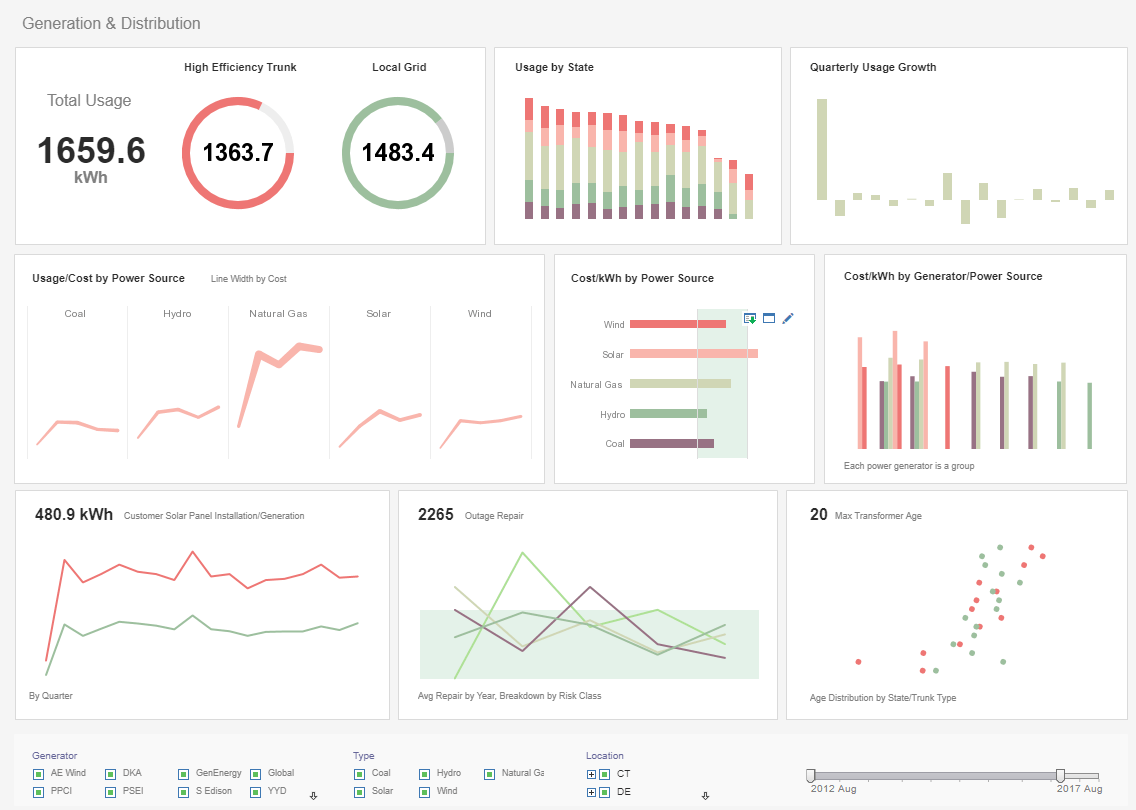Is there a good strategy for how to develop scorecards and dashboards?
This is a continuation of a transcript of a Webinar hosted by InetSoft entitled "Designing a Good Dashboard." The speaker is Mark Flaherty, CMO at InetSoft.
Mark Flaherty (MF): I am a huge believer in the incremental approach. You can start by understanding the vision and work on version 1 of the primary scorecard or dashboard. Deploy that to a hundred people. Then see what can be improved.
Then roll out version 2 to the remaining thousands of people. So implementing an incremental approach to rolling out dashboards and learning from users along the away, that’s definitely the way you want to approach to a BI project.
What is a scorecard?
Whenever you apply a threshold and best practice to whatever performance data you are looking at, that’s a scorecard. For example, in healthcare, the government administration is setting what are the thresholds for how a hospital qualifies to get future business from Medicaid or Medicare.
They have to have a certain level of infection rate, customer satisfaction, and quality of care. Once you apply to those mandates to your data, that’s a scorecard. So it’s a matter of context. You are measuring something and comparing to a particular corporate goal or benchmark.
That’s really what a scorecard is. Quite honestly, the hardest part to make the scorecard is really finding what those KPIs are, not designing one. That’s the real challenge.
| #1 Ranking: Read how InetSoft was rated #1 for user adoption in G2's user survey-based index | Read More |
What is the history of scorecards?
The balanced scorecard is a strategic planning and management system that is used extensively in businesses, government, and nonprofit organizations worldwide to align business activities to the vision and strategy of the organization, improve internal and external communications, and monitor organization performance against strategic goals. It was originated by Drs. Robert Kaplan (Harvard Business School) and David Norton as a performance measurement framework that added strategic non-financial performance measures to traditional financial metrics to give managers and executives a more 'balanced' view of organizational performance. While the phrase balanced scorecard was coined in the early 1990s, the roots of the this type of approach are deep, and include the pioneering work of General Electric on performance measurement reporting in the 1950’s and the work of French process engineers (who created the Tableau de Bord – literally, a "dashboard" of performance measures) in the early part of the 20th century.
The balanced scorecard has evolved from its early use as a simple performance measurement framework to a full strategic planning and management system. The “new” balanced scorecard transforms an organization’s strategic plan from an attractive but passive document into the "marching orders" for the organization on a daily basis. It provides a framework that not only provides performance measurements, but helps planners identify what should be done and measured. It enables executives to truly execute their strategies.
Case Study: Environmental Activism Group Using Scorecard Dashboards to Drive Performance and Impact
GreenEarth Alliance (GEA) is a leading global environmental activism group committed to advocating for climate action, sustainable development, and the protection of ecosystems. Founded in 1995, the organization operates through a network of regional offices, working on environmental campaigns such as deforestation prevention, marine conservation, and climate policy advocacy.
GreenEarth Alliance's mission centers on driving policy change through data-driven advocacy, raising public awareness, and mobilizing grassroots movements to protect the planet. Given the scale and complexity of its operations, the organization recognized the need for better tools to measure the effectiveness of its campaigns, allocate resources efficiently, and communicate impact to stakeholders. To meet these goals, GEA implemented a scorecard dashboard system, which integrated various Key Performance Indicators (KPIs) to track progress across its campaigns and operations.
This case study explores how GreenEarth Alliance uses scorecard dashboards to enhance its strategic decision-making, improve performance management, and amplify its environmental impact.
Challenges Before Scorecard Dashboards Implementation
Before adopting scorecard dashboards, GreenEarth Alliance faced several operational challenges that hindered its ability to scale campaigns and optimize resource allocation:
-
Difficulty in Measuring Impact: GEA's campaigns often involved multiple variables, such as public awareness, policy influence, and environmental outcomes. However, the organization struggled to measure the impact of its work in a structured and systematic way. Reports were often anecdotal, making it difficult to quantify success and improvement areas.
-
Fragmented Data and Reporting: Campaign teams collected data in silos, leading to fragmented reporting systems across various regions and projects. This resulted in inconsistent metrics and made it challenging to monitor overall organizational performance.
-
Inefficient Resource Allocation: Without a clear understanding of which campaigns were the most effective, GEA struggled to allocate resources efficiently. High-profile campaigns often received the most attention, even if smaller initiatives yielded better results.
-
Limited Stakeholder Engagement: Donors, activists, and other stakeholders were increasingly demanding transparency and measurable outcomes. GEA needed a system that could provide real-time insights into campaign performance and overall organizational impact, helping them report more effectively to funders and supporters.
The Solution: Implementation of Scorecard Dashboards
To address these challenges, GreenEarth Alliance implemented a balanced scorecard dashboard system from InetSoft, designed to provide real-time insights into its operations and campaigns. This dashboard system was customized to include key performance areas related to its organizational mission, such as advocacy success, environmental outcomes, and financial sustainability.
The scorecard dashboard system was designed around four key perspectives:
- Advocacy and Campaign Effectiveness
- Environmental Impact and Outcomes
- Operational Efficiency and Resource Management
- Stakeholder Engagement and Satisfaction
Each of these perspectives had its own set of KPIs, enabling GEA to track performance across multiple dimensions.
Key Performance Indicators (KPIs) Tracked on the Scorecard Dashboards
1. Advocacy and Campaign Effectiveness
Definition: KPIs under this perspective measure the success of GEA's campaigns in influencing policy, public awareness, and community actions.
-
Number of Policy Changes Influenced: Tracks how many legislative or regulatory changes have been influenced through GEA's advocacy efforts, such as new laws, amendments, or policy directives passed that align with environmental objectives.
-
Campaign Reach (Public Awareness): Measures the number of people engaged or reached through GEA's campaigns, including social media reach, event participation, and media coverage.
-
Petition Signatures Collected: Tracks the total number of petition signatures gathered in support of specific campaigns, such as climate action initiatives or anti-deforestation efforts.
-
Grassroots Participation: Measures the level of volunteer and grassroots involvement in campaigns, indicating how successfully the group mobilizes public support at a community level.
Significance: These KPIs allow GEA to measure both the direct and indirect impact of its advocacy work. For example, tracking policy changes influenced helps the organization understand its success in shaping laws, while campaign reach and petition signatures provide insight into how effectively it's raising awareness and garnering support.
2. Environmental Impact and Outcomes
Definition: This perspective tracks the tangible environmental outcomes resulting from GEA's activities.
-
Carbon Emissions Reduced (Tons of CO₂): Measures the reduction in carbon emissions as a result of GEA's climate campaigns, such as tree-planting initiatives or lobbying for renewable energy policies.
-
Hectares of Forest Protected or Reforested: Tracks the number of hectares of forests saved from deforestation or restored through reforestation efforts led or supported by GEA.
-
Marine Biodiversity Protection: Measures the success of marine conservation efforts by tracking metrics such as the reduction of illegal fishing activities or the number of marine species protected.
-
Waste Diverted from Landfills (Tons): Monitors how much waste has been diverted from landfills due to GEA's zero-waste campaigns and recycling initiatives.
Significance: Environmental outcomes are the ultimate measure of success for an environmental activism group like GreenEarth Alliance. These KPIs directly align with GEA's mission to protect and restore ecosystems, allowing the organization to quantify its environmental footprint reduction efforts.
3. Operational Efficiency and Resource Management
Definition: These KPIs track how efficiently GEA manages its internal resources, including staff, financial resources, and operational processes.
-
Project Completion Rate (% on Time): Measures the percentage of GEA's projects completed on time, helping the organization track its operational efficiency and adherence to project timelines.
-
Cost per Campaign ($): Tracks the financial cost associated with each campaign, including labor, marketing, and operational expenses, allowing GEA to understand which initiatives provide the best return on investment (ROI).
-
Staff Utilization Rate (%): Measures how effectively GEA's staff are being utilized across different campaigns and initiatives, including volunteer engagement and contributions from partner organizations.
Significance: By monitoring operational efficiency, GEA ensures that it maximizes the impact of every dollar spent. Tracking project completion and campaign costs allows management to identify inefficiencies and allocate resources more effectively, ensuring that more funds go toward high-impact initiatives.
4. Stakeholder Engagement and Satisfaction
Definition: These KPIs measure the organization's ability to maintain strong relationships with stakeholders, including donors, activists, volunteers, and the public.
-
Donor Retention Rate (%): Measures the percentage of donors who continue to support GEA year after year, indicating the organization's ability to maintain strong relationships with its funding base.
-
Volunteer Satisfaction Score (%): Tracks the level of satisfaction among volunteers through surveys and feedback forms, providing insight into how well GEA supports and engages its grassroots activists.
-
Media Engagement Score: Measures the organization's visibility in the media, including press mentions, media partnerships, and social media engagement, helping GEA assess the success of its media outreach efforts.
Significance: Maintaining strong relationships with donors, volunteers, and the public is crucial for the long-term success of GEA. High donor retention and volunteer satisfaction scores indicate that the organization is building lasting relationships and that its efforts are resonating with its supporters.
Results and Benefits of Scorecard Dashboards Implementation
The introduction of scorecard dashboards provided GEA with several critical benefits that enhanced the effectiveness of its campaigns and overall organizational performance.
1. Improved Campaign Performance Management
By visualizing real-time data on its scorecard dashboards, GEA was able to monitor the progress of ongoing campaigns more effectively. For example, in one deforestation campaign, the scorecard indicated that media engagement was low relative to the number of petition signatures, prompting the campaign team to adjust their outreach strategy. As a result, media visibility increased, boosting the overall success of the campaign.
2. Better Resource Allocation
With clear insights into which campaigns were generating the highest environmental and advocacy outcomes, GEA was able to allocate resources more efficiently. This data-driven approach allowed the organization to prioritize campaigns with the highest impact potential, leading to better use of financial resources and staff time.
3. Enhanced Stakeholder Communication
The dashboard system enabled GEA to generate detailed, data-backed reports for donors, activists, and the general public. These reports provided transparency and showcased the tangible impact of their work, leading to higher donor retention rates and increased trust among stakeholders.
4. Proactive Environmental Action
The environmental impact KPIs provided GEA with the ability to track and forecast environmental outcomes. In one case, the dashboards revealed that a marine conservation initiative was falling short of its biodiversity protection goals. Armed with this data, GEA was able to adjust its strategy, resulting in stronger partnerships with local governments and an expansion of protected marine areas.
| Previous: Industry Templates for Dashboards |


